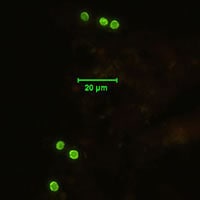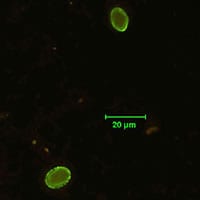
Monthy Case Studies - 2003
Case #118 - October, 2003
An outbreak of diarrhea affecting persons from one year of age to 70 years of age occurred in the Northeast region of Kansas. Fecal specimens were collected in 10% formalin and concentrated using the FEA concentration method. Direct fluorescent antibody assays (Merifluor DFA kits) were performed on the samples by the county and state health departments. To date, test results confirmed that over a hundred specimens had the objects shown in Figure A. What is your diagnosis? Based on what criteria? Figure B shows what was found in 5 specimens tested. What is your diagnosis? Based on what criteria?

Figure A

Figure B
Acknowledgement: This case kindly provided by the Kansas Department of Health and Environment and the Douglas County Health Department.
Answer to Case #118
Figure A showed oocysts of Cryptosporidium spp. The objects seen in Figure B were cysts of Giardia duodenalis. Diagnostic features observed included:
Cryptosporidium spp.
- round oocysts within the size range for Cryptosporidium spp. (4 to 6 µm in diameter).
Giardia duodenalis
- oval cysts within the size range for G. duodenalis (8 to 12 µm in length).
DFA offers the highest combination of sensitivity and specificity compared to other techniques and is considered the gold standard by many laboratories. When using DFA testing, size and shape are the differentiating features to identify and distinguish between Cryptosporidium and Giardia. Of note, more than one half of all positive specimens from this Cryptosporidium outbreak were from children age 18 and younger, and a significant number of those cases were associated with day care facilities.
More on: Cryptosporidiosis
More on: Giardiasis
Images presented in the monthly case studies are from specimens submitted for diagnosis or archiving. On rare occasions, clinical histories given may be partly fictitious.
 ShareCompartir
ShareCompartir


